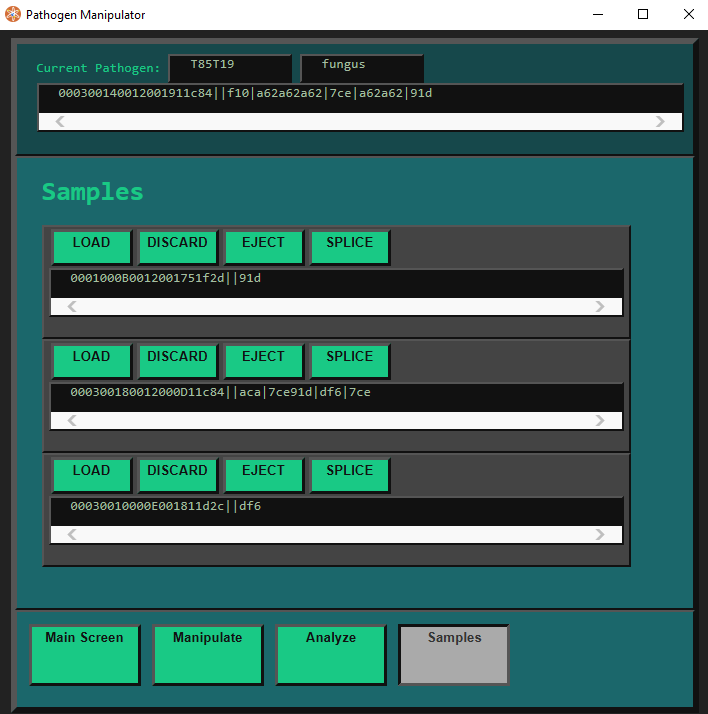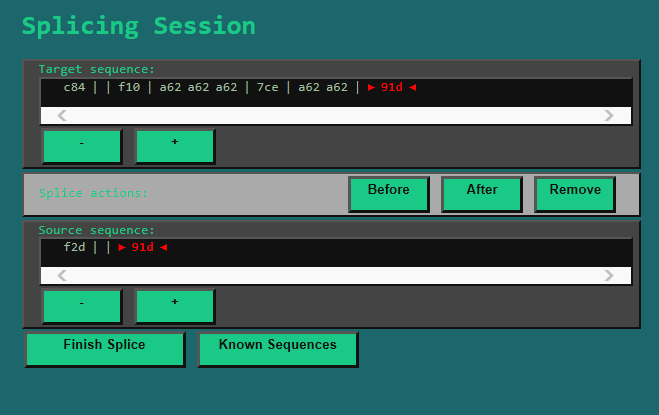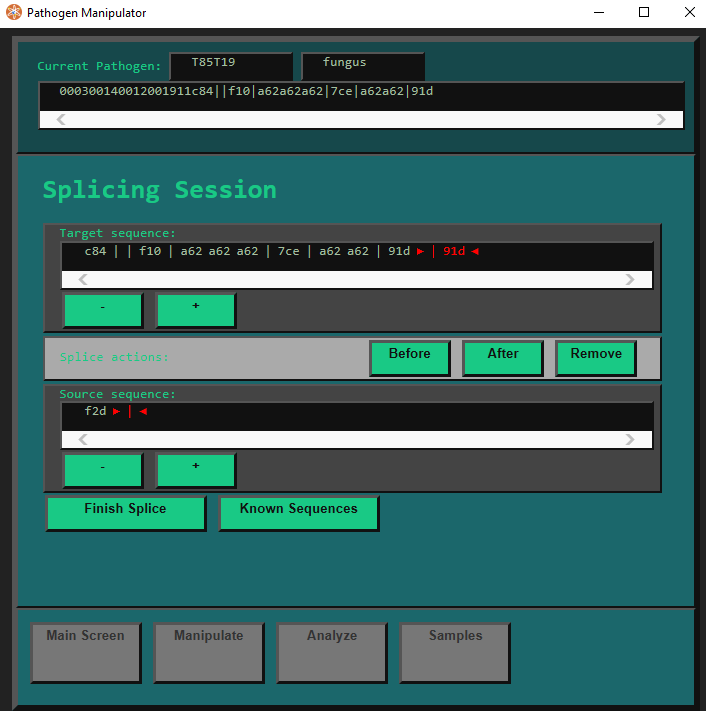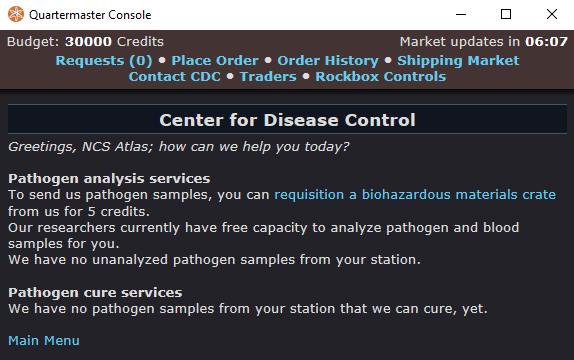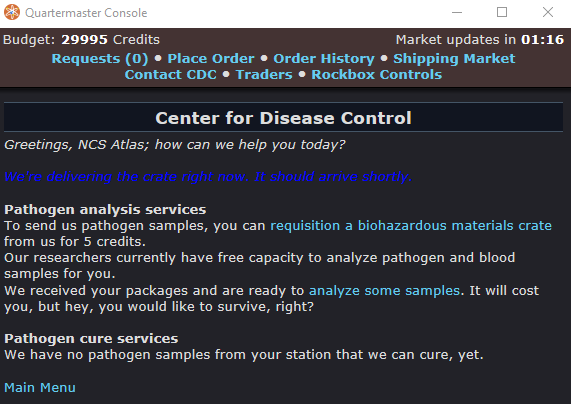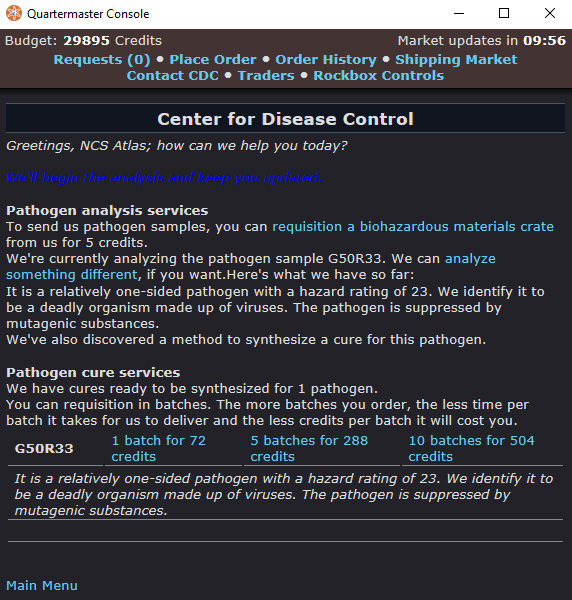Guide to Pathology: Difference between revisions
Studenterhue (talk | contribs) Adds Department Guides template and supplementary video from one of previous patho guides |
Studenterhue (talk | contribs) →Suspension of Player Access to Pathogens: Since the CDC was removed when PR #18336, have to adjust description about its current state and instructions on re-enabling access |
||
| (25 intermediate revisions by 6 users not shown) | |||
| Line 1: | Line 1: | ||
{{ | {{Historical|Notes=Pathology has been officially discontinued by the developers}} | ||
A pathogen is a disease that can have many different effects. These are combined together by a pathologist, so each pathogen you encounter will likely be unique. | A pathogen is a disease that can have many different effects. These are combined together by a pathologist, so each pathogen you encounter will likely be unique. | ||
A pathogen is defined by several things: | A pathogen is defined by several things: | ||
==Suspension of Player Access to Pathogens== | |||
In May 2020, the admin team decided to suspend player access to pathology by removing or reworking various sources of pathogens through code and map changes, for a number of reasons explained in [https://forum.ss13.co/showthread.php?tid=14435 this thread]. Months later, in 2021, from January 13th to January 20th, it was re-enabled for testing. Pathology still remains disabled for the most part. | |||
The [[Pathology|pathology labs]] are still there for the most part, though slightly modified, all the machines described below are still around, and pathogens still work as described below too, but you just can't get find pathogens as a normal player, barring [[Admin]] shenanigans and the odd diseased "burgle" in the Afterlife Bar. | |||
=== Re-enabling Access === | |||
If you want to re-enable player access to pathology to test out your new pathology code or just for your own curiosity, you need to go to '''pathology.dm''' in the goonstation/_std/defines folder and uncomment <code>//#define CREATE_PATHOGENS 1</code>, so it becomes <code>#define CREATE_PATHOGENS 1</code>. This of course requires downloading and compiling the code, which is explained in the [https://hackmd.io/@goonstation/docs/%2F%40goonstation%2Fdev Goonstation Development Guidelines]. | |||
Uncommenting the <code>CREATE_PATHOGENS</code> define does the following: | |||
*Turns the water in [[Medical Objects#Totally Safe(tm) Pathogen Sample|Totally Safe(tm) pathogen sample vials]] into actual pathogen reagent. | |||
*Allows the [[#Synth-O-Matic|Synth-O-Matic]] to create [[Medical Objects#Totally Safe(tm) Pathogen Sample|said sample vials]]. | |||
*Lets you buy [[Medical Objects#Totally Safe(tm) Pathogen Sample|said pathogen sample vials]] and [[Medical Objects#Synth-O-Matic Module|Synth-O-Matic modules]] from D.O.C., a medical-themed trader than appears in the [[Debris Field]] on space maps and around the station z-level for ocean-based maps. Randomly-generated NPC merchants may also buy or sell them. | |||
*Stocks pathogen cabinets, like the ones in [[Pathology#Manta|Manta's pathlogy lab]] with [[Medical Objects#Totally Safe(tm) Pathogen Sample|pathogen sample vials]], instead of letting them sit there sad and empty. | |||
*Enables [[Foods and Drinks#Cookie Dough|cookie dough]] and moldy burgers to infect you with pathogens when eaten. | |||
*Makes [[Doctoring#Appendicitis|appendicitis]] fill the inflicted with several pathogens at the final stage. | |||
*When the motives system is on, causes reaching 0 on the Hygiene motive to infect you with some pathogens. | |||
Note it does not reverse the various map changes that came along with the suspension of player access to pathology. In addition, this does not re-enable the CDC; that feature was gutted from the code entirely (this page includes instructions on using the CDC purely for historical interest.) | |||
== Stats == | == Stats == | ||
| Line 56: | Line 75: | ||
|Biocide | |Biocide | ||
|{{No}} | |{{No}} | ||
|{{ | |{{Yes}} | ||
|{{No}} | |{{No}} | ||
|- id="Bacterium" | |- id="Bacterium" | ||
| Line 76: | Line 95: | ||
|Biocide | |Biocide | ||
|{{Yes}} | |{{Yes}} | ||
|{{ | |{{Yes}} | ||
|{{No}} | |{{No}} | ||
|- id="mutatis" | |- id="mutatis" | ||
| Line 86: | Line 105: | ||
|Mutation Inhibitor | |Mutation Inhibitor | ||
|{{No}} | |{{No}} | ||
|{{ | |{{Yes}} | ||
|{{Yes}} | |{{Yes}} | ||
|} | |} | ||
| Line 242: | Line 261: | ||
Well, for this we will be using the Splicing system!<br/> | Well, for this we will be using the Splicing system!<br/> | ||
First of all, we should get ourselves plenty of different samples. This can be done at the Synth-O-Matic! [[Image: Synth-O-Matic.png]]<br/> | First of all, we should get ourselves plenty of different samples. This can be done at the Synth-O-Matic! [[Image: Synth-O-Matic.png]]<br/> | ||
For making a testing pathogen, | For making a testing pathogen, Fungus is a good choice, since it can support an infinite amount of Segments. Other microbodies will collapse if you try to Splice too many Symptoms onto them! (See Section on Microbodies)<br/> | ||
Once you have your Samples, just put them all into the Pathogen Manipulator by clicking. It can hold up to 4 at a time. (Counting the currently active Sample.)<br/> | Once you have your Samples, just put them all into the Pathogen Manipulator by clicking. It can hold up to 4 at a time. (Counting the currently active Sample.)<br/> | ||
| Line 269: | Line 288: | ||
A sample needs to have at least 2 units of pathogen (a mechanical dropper can be used to transfer exactly 2 units). | A sample needs to have at least 2 units of pathogen (a mechanical dropper can be used to transfer exactly 2 units). | ||
All you need to watch out for is the pathogen running out of nutrients and not to remove the last bit of pathogen from the petri dish. | All you need to watch out for is the pathogen running out of nutrients and not to remove the last bit of pathogen from the petri dish. | ||
You can also use the Incubator, it will automatically keep one petri dish supplied with nutrients, and you can use a vial on it to fill it with pathogen (if there is enough in the petri dish). | |||
If you are familiar with a reagent heater, the Incubator looks | You can also use the Incubator, it will automatically keep one petri dish supplied with nutrients, and you can use a vial on it to fill it with pathogen (if there is enough in the petri dish). If you are familiar with a reagent heater, the Incubator looks fairly similar. [[File:IncubatorV2-32x32.png]] | ||
== Handling Infections == | == Handling Infections == | ||
It should be noted that deliberately spreading/infecting people with pathogens is considered [[Grief]]. If you're really to give people a beneficial pathogen, please ask them first! (And remember, silence does not imply consent.) | |||
How do pathogens spread? All pathogens spread through blood and liquid samples of it, and some pathogens have Symptoms that allow it to spread by other means. | |||
*'''Pathogen Reagent''' - You know that "pathogen" reagent you manipulate when using incubators and microscopes and such? If you get it injected into your bloodstream (for whatever reason), you will be infected with it. Getting splashed with pathogen can infect you too, but the chance of catching it is reduced by disease resistance, which is mainly modified by clothing. Naturally, a biosuit/hood or a spacesuit/helmet combo will protect against any diseases splashed onto a person. | |||
*'''Blood''' - Blood from an afflicted person can also infect those who receive said blood, such as by [[Medical Objects#Syringe|syringe]] or [[Medical Objects#Hypospray|hypospray]]. If you do not know the donor, it's not always apparent that the blood is infected; you often need to put some blood a blood slide and run it through the centrifuge first to tell. You might expect a [[Vampire]] to be especially at risk for pathogens because they "handle" blood so much, but Vampires are handily immune to diseases. | |||
*'''Spreading Symptoms''' - If pathogen has one or more spreading Symptoms (coughing, sneezing, farting, hugging, etc...), and its Spread Stat is not 0, it will also be able to spread itself! How exactly this goes down depends on the Symptom in question, you can read up on this on the [[Pathogen Symptoms & Mutations]] page. | |||
**'''Disease Clouds''' - Some Symptoms make clouds of "disease particles". Walking through them has a 10% chance to infect you. This is blocked entirely by all varieties of space helmets and diving helmets, [[Clothing#Gas Mask|gas masks]] (and its emergency and [[Security Objects#NT-SO Gas Mask|NT-SO]] variants), [[Medical Objects#Sterile Mask|sterile masks]], [[Clothing#Biosuit|biohoods]], [[Medical Objects#Surgical Face Shield|surgical face shields]], and [[Clothing#Plague Doctor Mask|plague doctor masks]]. You might not expect it, but [[Janitor#The Janitor's Arsenal|janitor equipment]] can clear away disease particles, though [[Engineering Objects#Air Scrubber|air scrubbers]] can't. | |||
**'''Disease Puddles''' - The Sweating Symptom specifically creates puddles of "weirdly colored sweat". Anyone who walks over these has a 4% chance to get infected, which, like pathogen splashes, is reduced by disease resistance. These puddles can be cleaned up by most [[Janitor#The Janitor's Arsenal|janitor equipment]], naturally. | |||
**'''Touch''' - The Sweating and Oxycontin Production Symptoms also specifically allow the possibility of the disease spreading via punches/kicks, grabs, and disarms, with Oxycontin Production also allowing hugs to infect people. A successful infection is indicated by a distinct message. | |||
Notice that unlike in real life, there are no animal vectors or fomites (infected surfaces), and airborne and touch transmission are possible only via specific, highly-visible Symptoms. That means it's usually fine to handle an afflicted person's items or be in the same room as them, though for the last it's obviously a different story if they're sneezing, coughing, or otherwise spreading the pathogen due to a Symptom. | |||
Also unlike in real life, a person can be afflicted with only one pathogen at a time. Someone already infected can only get a new infection if they are exposed to a pathogen with at least one Symptom that is higher in tier than the highest tier Symptom in the existing pathogen, in which case the new disease "overwrites" the prevoius one. For example, say you're afflicted with a pathogen whose highest tier Symptom is Oxygen Farts, tier 2 Symptom. You can't get infected by a pathogen whose highest tier Symptom is Snapping, another tier 2 Symptom, but you can be infected by one with Projectile Bee Egg Sneezing, a tier 3 Symptom, in which case you lose the pathogen with Oxygen Farts but gain the one with Projectile Bee Egg Sneezing. | |||
But more like real life, if someone gets infected and is cured, they're immune to it. They can't get infected again! | |||
== Curing Disease == | == Curing Disease == | ||
| Line 318: | Line 346: | ||
==Supplementary Video== | ==Supplementary Video== | ||
<youtube>0PzqGcL7g1M</youtube> | <youtube>0PzqGcL7g1M</youtube> | ||
{{Archive}} | |||
{{ | |||
Latest revision as of 05:12, 30 March 2024
| This page is about discontinued content. The following information is not current. It is kept for historical purposes. Pathology has been officially discontinued by the developers |
A pathogen is a disease that can have many different effects. These are combined together by a pathologist, so each pathogen you encounter will likely be unique.
A pathogen is defined by several things:
Suspension of Player Access to Pathogens
In May 2020, the admin team decided to suspend player access to pathology by removing or reworking various sources of pathogens through code and map changes, for a number of reasons explained in this thread. Months later, in 2021, from January 13th to January 20th, it was re-enabled for testing. Pathology still remains disabled for the most part.
The pathology labs are still there for the most part, though slightly modified, all the machines described below are still around, and pathogens still work as described below too, but you just can't get find pathogens as a normal player, barring Admin shenanigans and the odd diseased "burgle" in the Afterlife Bar.
Re-enabling Access
If you want to re-enable player access to pathology to test out your new pathology code or just for your own curiosity, you need to go to pathology.dm in the goonstation/_std/defines folder and uncomment //#define CREATE_PATHOGENS 1, so it becomes #define CREATE_PATHOGENS 1. This of course requires downloading and compiling the code, which is explained in the Goonstation Development Guidelines.
Uncommenting the CREATE_PATHOGENS define does the following:
- Turns the water in Totally Safe(tm) pathogen sample vials into actual pathogen reagent.
- Allows the Synth-O-Matic to create said sample vials.
- Lets you buy said pathogen sample vials and Synth-O-Matic modules from D.O.C., a medical-themed trader than appears in the Debris Field on space maps and around the station z-level for ocean-based maps. Randomly-generated NPC merchants may also buy or sell them.
- Stocks pathogen cabinets, like the ones in Manta's pathlogy lab with pathogen sample vials, instead of letting them sit there sad and empty.
- Enables cookie dough and moldy burgers to infect you with pathogens when eaten.
- Makes appendicitis fill the inflicted with several pathogens at the final stage.
- When the motives system is on, causes reaching 0 on the Hygiene motive to infect you with some pathogens.
Note it does not reverse the various map changes that came along with the suspension of player access to pathology. In addition, this does not re-enable the CDC; that feature was gutted from the code entirely (this page includes instructions on using the CDC purely for historical interest.)
Stats
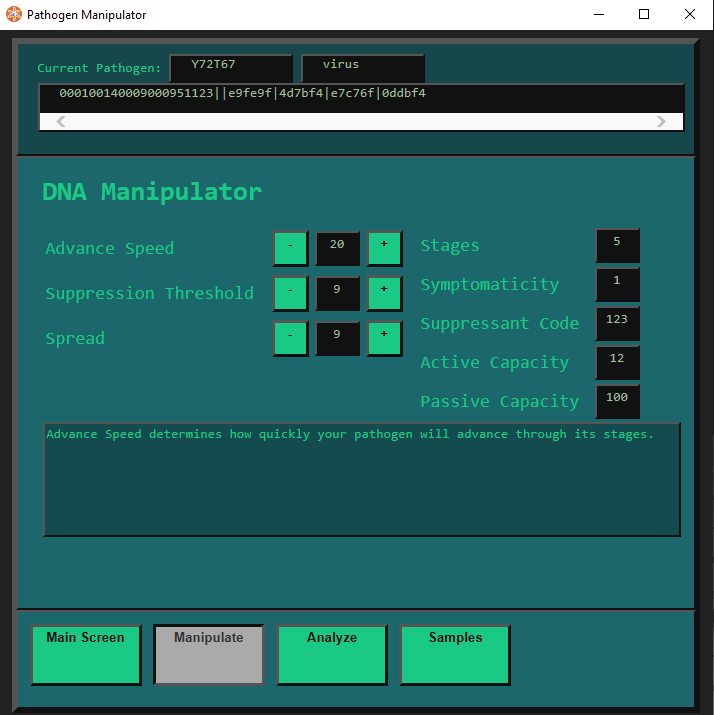
These are numerical values between 0 and 50 that influence how well the pathogen can do certain things. A pathologist can set these stats directly in the Pathogen Manipulator.
- Advance Rate: This determines how quickly the pathogen will advance through its Stages. It will also determine how quickly it goes down through the stages when suppressed or in remission.
- Spread: This determines how well the pathogen will spread from person to person. This also depends on the pathogen's Symptoms. A pathogen with 0 spread will not spread at all by itself.
- Suppression Threshold: This determines how easily a pathogen can be suppressed via its Suppressant.
A pathogen has only a limited amount of points to spread over these stats, so if it is very good in some stats, the other stats will probably be lower to compensate. The amount of points a pathogen has to spread is known as its Passive Capacity.
Microbody Type
The specific type of pathogen. There are four different types (plus a fifth that only occurs when the admins bombard the station with diseased burgles).
A specific sample has a specific type, and it is unchangeable, so you will need to find a sample with the type you want and then build off of that for your disease.
The microbody type influence a handful of things:
- Stages: The maximum stage that the pathogen can reach. More on stages later.
- Active Capacity: This determines how many symptoms (and of what length) the pathogen can support. Adding any more will destroy the pathogen. More on symptoms later.
- Activity: How often the pathogen can trigger its symptoms. This also differs depending on the pathogens stage.
- Growth Medium: What type of Growth Medium needs to be added to a petri dish in order for the pathogen to grow. This is a chemical.
- Anti-Agent: What type of Anti-Agent needs to be used to make a cure in the Synth-O-Matic. This is a chemical.
- Vaccinable: If a Vaccine can be made for the pathogen.
- Auto-Immunization: If you are immune to the pathogen after you have been cured of it once.
Here are the different microbody types:
| Microbody | Stages | Activity | Active Capacity | Growth medium | Anti-agent | Vaccinable | Self- immunization |
Admin-only |
|---|---|---|---|---|---|---|---|---|
| Virus | 5 | 1, 5, 20, 30, 40 | 12 | Egg | Antiviral Agent | Yes | Yes | No |
| Parasite | 5 | 50, 40, 30, 20, 10 | 18 | Parasitic Medium | Biocide | No | Yes | No |
| Bacterium | 3 | 30, 30, 30 | 25 | Bacterial Medium | Spaceacillin | Yes | Yes | No |
| Fungus | 1 | 10 | ∞ | Fungal Medium | Biocide | Yes | Yes | No |
| Great Mutatis | 5 | 20, 20, 20, 20, 20 | ∞ | Stable Mutagen | Mutation Inhibitor | No | Yes | Yes |
For instance, lets say you are infected by a virus. It starts out in stage 1 (as all infections do). While in stage 1, it will only have a 1% chance to trigger it's symptoms, which is very low! But as it progresses through the stages, it will trigger more and more, with up to a 40% chance to possibly trigger symptoms at stage 5.
Something like a Parasite, on the other hand, will start out at 40% in stage 1, so it might spread very quickly! But as it progresses through the stages, it will trigger a bit less (though still a fair amount). This can be helpful for diseases meant to spread quickly, or that have symptoms where it doesn't really matter how much they trigger, because they mainly have passive effects.
A bacterium has a constant activity, so it always triggers at an ok rate, but it can only progress up to stage 3. This means that the symptoms will be a bit weaker, and some really strong effects may never be able to trigger (stuff like gibbing from tier 5 symptoms, for instance). The main advantage of the bacterium though, is that it you can put a lot more symptoms on it than on a virus or parasite, so you might want to go for it if you want a wide variety of effects that are maybe a bit weaker.
Now, you may be thinking, hold on, the fungus is complete garbage! You are correct, the main purpose of a fungus is for it to be used to cultivate lots of symptoms on it, even if you never intend to actually infect anyone with the fungus. You will see what this comes in handy for later, in the section on how to find new symptoms!
Suppressant
The Suppressant, like the microbody type, is an inherent, unchangeable property of a pathogen sample. It is a specific type of stimulus that the pathogen is weak to. When a pathogen is exposed to its suppressant, it might start to regress through its stages, becoming less powerful. Prolonged exposure might even cause it to go into remission, eventually being cured completely. There are a handful of different suppressants, which can be applied in different ways.
You aren't told explicitly what a pathogens suppressant is, it requires a little bit of detective work! Suppressants are split into a few different groups, a quick inspection with a health analyzer or microscope will tell you the group, but not the exact suppressant itself. To find out the precise type, you then simply put a petri dish with a sample of the pathogen under a microscope and use a dropper to drip a little bit of a related chemical into the dish. If the pathogen reacts, you will know that you found the correct suppressant! You can also tell what the suppressant is by the color that the pathogen is when seen under a microscope.
| Group | Suppressant | Trigger | Color | Associated Chemicals |
|---|---|---|---|---|
| Thermal | Heat | Afflicted needs to have a high body temperature | Blue | Phlogiston, Chlorine Trifluoride |
| Cold | Afflicted needs to have a low body temperature | Red | Cryostylane, Cryoxadone | |
| Sedative | Sedative | Afflicted needs to sleep | Green | Morphine, Ketamine |
| Muscle Relaxant | Afflicted needs to have related chemicals in bloodstream, or receive electric shocks | White | Haloperidol, Neurotoxin | |
| Medical | Brute Medicine | Afflicted needs to have related chemicals in bloodstream | Black | Styptic Powder, Synthflesh |
| Burn Medicine | Afflicted needs to have related chemicals in bloodstream | Cyan | Silver Sulfadiazine, Synthflesh | |
| Gastronomical | Fat | Afflicted needs to have related chemicals in bloodstream | Orange | Partially Hydrogenated Space-Soybean Oil, Space-Soybean Oil, Porktonium, Cholesterol |
| Chicken Soup | Afflicted needs to have related chemicals in bloodstream | Pink | Chicken Soup | |
| Radioactive | Radiation | Afflicted needs to be irradiated | Viridian | Radium, Unstable Mutagen, Uranium, Polonium |
| Mutagen | Afflicted needs to have related chemicals in bloodstream | Olive Drab | Unstable Mutagen, Stable Mutagen |
Suppressants also have a use in manufacturing cures, but these days they aren't really necessary any more.
Symptoms

Symptoms, aka, the fun part of Pathology!
They are what determines what your Pathogen will actually do! Most of the time in creating a Pathogen goes into finding the Symptoms you want.
Each Symptom has a unique code that is made of segments. Each segment is a combination of three letters or digits. There are five different tiers of Symptoms, with tier 1 Symptoms being the weakest, but only needing one segment, while tier 5 are the strongest, but are made of five segments.
Everything after the || is the Pathogen's Symptoms! The individual Symptom's codes are separated with |, so as you can see, we have four different Symptoms, one tier 2 Symptom (ffe 001) and three tier 1 Symptom (2e6, ffe, 9dd)!
Examining Symptoms
Now, how do we find out which Symptoms these codes correspond to? For this we will use our good friend, the microscope! ![]()


- Remove your sample from the Pathogen Manipulator and put it into a petri dish. Then put the petri dish into the microscope, so you can inspect it!
- Optional: If you think you might take a while to perform these steps, you may want to put some of the appropriate nutrient type into the petri dish as well, or your sample might starve.
- Clicking the microscope will then allow you to view the sample in two different ways, either zoomed-out or zoomed-in.
- For checking Symptoms, you'll want the zoomed-in view, so click on that one!
- The first part of the output in our example (suppressed by something affecting neural activity) shows that the Pathogen's Suppressant is of the sedative variety.
- The rest is a bunch of hints, the code next to the hint shows you which Symptom code gave them. Now we just need to figure out what Symptoms these hints are referring to. For this we have a helpful reference guide for the different types of Symptoms! You can find it here!
- Now, armed with the knowledge that 'ffe001' is a tier 2 symptom with the hint 'The pathogen appears to generate a high amount of fluids.' we can figure out that it must be either the Sneezing or the Coughing Symptom.
- If we wanted to find out which one of the two, we could get ourselves some Pepper from the kitchen and use a Dropper to drip some of it into the petri dish.
- We can then observe an addition in the microscope output.
- As we can see in the last part, the Sample exhibits the behavior of Sneezing when it interacts with Pepper, so we know that it is Sneezing, and not Coughing! If this seems like a lot of work for one Symptom, don't worry, most of the time you can figure out what a Symptom is without needing to test with Chemicals. Also, you don't always need to figure out exactly what all the smaller Symptoms do, if you are going for big ones anyway!
Finding new Symptoms
Ok, now you may be wondering, all these samples I have contain tier 3 Symptoms at best! What if I want my Pathogen to turn everyone into a pile of ash??
Well, you're going to need to find some bigger Symptoms!
For this, we are going to use the DNA Analyzer function of the Pathogen Manipulator.

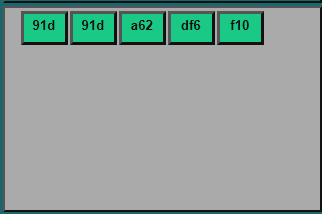
- First, we are going to press the 'Split DNA' button, watch out, this will destroy the currently active Sample in the Pathogen Manipulator!
The destroyed Sample's Symptoms will be broken up into the individual Segments and you will be able to combine the Segments to try to find new Symptom Codes.
Of course, you don't need to do this completely at random! Once you have tested a combination, the lights on the right side will show you some information about that attempt!
If your combination was Stable, that means that it is a valid Symptom that you can put into a Pathogen!
If it was Transient that means that while it is not necessarily Stable, there is another Symptom Code that starts with your combination that is Stable.
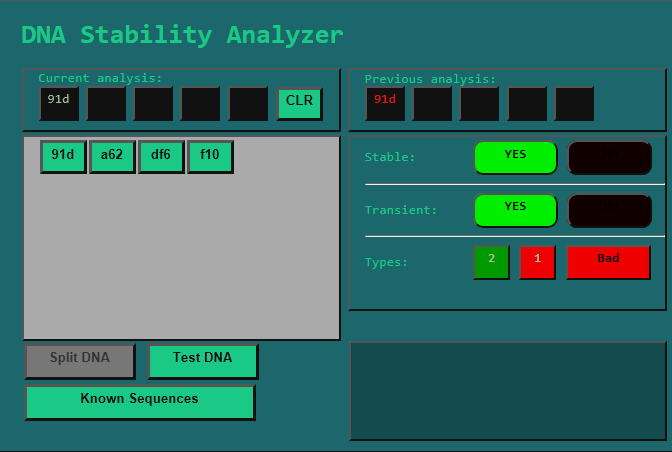
For instance, in our example we start with the segment '91d'. We see that '91d' is both Stable and Transient. This means that we could put '91d' as a Symptom into a Pathogen and it would work! (Which makes sense, since it was already in the Pathogen that we split.) Furthermore, it also tells us that there is at least one other valid Symptom that starts with '91d'. Now, if we look a bit lower, we will see that the Types analysis tells us that there are 2 Good Transient Symptoms and 1 Bad Transient Symptom. Symptoms are split into two categories, Good Symptoms are generally the kind that a person would be happy to have, while Bad Symptoms are usually the ones that harm the Afflicted. The big red lamp on the right side that says "Bad" tells us what kind the symptoms we just tested is.
So, to sum it up, we now know that:
- '91d' is a valid Symptom. It is of the "Bad" variety.
- There are three other Symptoms that start with '91d', two of them Good, one of them Bad.
So, naturally, our next step would be to try to add more Segments on to '91d', to see if we can find one of those higher tier Symptoms!
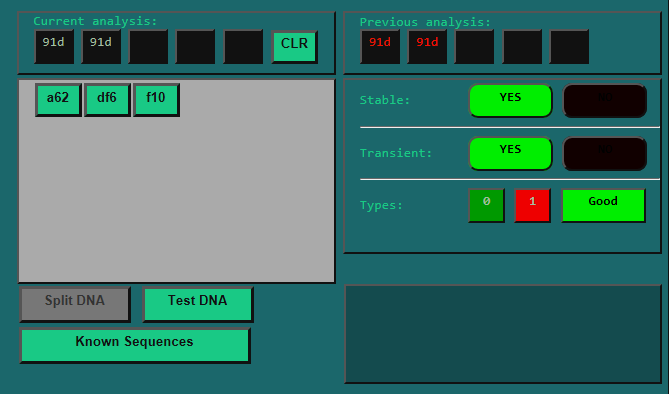
Huzzah! As you can see, this is also a valid Symptom! It is even transient, so there is another Symptom of at least Tier 3 that starts with '91d 91d'.
We also now know that '91d 91d' is a Good Symptom, which might be nice if we are a non-traitor pathologist.
If we check the Pathogen Symptoms & Mutations page, we see that it must be one of the following:
- Detoxication
- Oxygen Farts
- Wound Mending
- Burn Healing
On the other hand, if you are a traitorous pathologist, you may wish to instead try more combinations that start with '91d 91d' in order to find the higher tier symptom that is harmful.
There are always 6 different Segments in each round, but you can see that the pathogen we split only had 4 different Segments. (91d, a62, df6, f10)
This means that I may not necessarily be able to find this higher tier Symptom with the Segments I have available, because what if the combination I need is something like '91d 91d aca'?
For this reason it is usually a good idea to first make a Fungus with every kind of Segment (and lots of them, so you can use them to combine more often before having to load in a new sample).
Splicing Pathogens
Alright, so how do we make a testing pathogen for finding new combinations? And how do we put the combinations we find into an actual pathogen?
Well, for this we will be using the Splicing system!
First of all, we should get ourselves plenty of different samples. This can be done at the Synth-O-Matic! ![]()
For making a testing pathogen, Fungus is a good choice, since it can support an infinite amount of Segments. Other microbodies will collapse if you try to Splice too many Symptoms onto them! (See Section on Microbodies)
Once you have your Samples, just put them all into the Pathogen Manipulator by clicking. It can hold up to 4 at a time. (Counting the currently active Sample.)
Next, simply click a SPLICE button to start splicing the active Sample together with the Sample whose SPLICE button you clicked.
Now you can splice any Symptom Segments you want from the bottom Sample into the top Sample with the Before and After buttons.
The Remove button can be used to remove any Segments you do not want.
The + and - buttons let you change the size of your selection, so you can transfer more than one Segment at once.
Remember that all the Symptoms (the stuff between the |s) in the top Sample will need to be valid Symptoms, or the Sequence will collapse and the Sample will be lost!
The Sequence will also collapse if the amount of Symptom Segments exceeds the Microbodies' Active Capacity. (as mentioned in the section on Microbodies).
Another tip: the part before the || is the Suppressant code, do not modify it, and do not attempt to put the one from the bottom into the top sample. There is no point and it'll probably mess up your Sample.
(In this case that would be f2d.)
Here is what we end up with in this case:
Once you are done, click the Finish Splice button.
Now we do this for all the other Samples too, and end up with a really long supersample, which we can use to experiment and find new Symptom Codes!

Growing more Pathogen
Of course, using the DNA Analyzer on a Sample will destroy the Sample, and we wouldn't want to use up the Sample we just put so much work into, right? That is why we simply make it grow to obtain more Samples that are exactly the same as our initial one!
- Put the sample from the vial into a petri dish.
- Add some nutrients to the petri dish, of the appropriate type for the microbody. The table for this can be found here.
- Wait a minute or two until the pathogen starts to grow.
- Transfer pathogen from the dish into vials, making sure to keep some in the dish so it can continue to multiply.
A sample needs to have at least 2 units of pathogen (a mechanical dropper can be used to transfer exactly 2 units). All you need to watch out for is the pathogen running out of nutrients and not to remove the last bit of pathogen from the petri dish.
You can also use the Incubator, it will automatically keep one petri dish supplied with nutrients, and you can use a vial on it to fill it with pathogen (if there is enough in the petri dish). If you are familiar with a reagent heater, the Incubator looks fairly similar. ![]()
Handling Infections
It should be noted that deliberately spreading/infecting people with pathogens is considered Grief. If you're really to give people a beneficial pathogen, please ask them first! (And remember, silence does not imply consent.)
How do pathogens spread? All pathogens spread through blood and liquid samples of it, and some pathogens have Symptoms that allow it to spread by other means.
- Pathogen Reagent - You know that "pathogen" reagent you manipulate when using incubators and microscopes and such? If you get it injected into your bloodstream (for whatever reason), you will be infected with it. Getting splashed with pathogen can infect you too, but the chance of catching it is reduced by disease resistance, which is mainly modified by clothing. Naturally, a biosuit/hood or a spacesuit/helmet combo will protect against any diseases splashed onto a person.
- Blood - Blood from an afflicted person can also infect those who receive said blood, such as by syringe or hypospray. If you do not know the donor, it's not always apparent that the blood is infected; you often need to put some blood a blood slide and run it through the centrifuge first to tell. You might expect a Vampire to be especially at risk for pathogens because they "handle" blood so much, but Vampires are handily immune to diseases.
- Spreading Symptoms - If pathogen has one or more spreading Symptoms (coughing, sneezing, farting, hugging, etc...), and its Spread Stat is not 0, it will also be able to spread itself! How exactly this goes down depends on the Symptom in question, you can read up on this on the Pathogen Symptoms & Mutations page.
- Disease Clouds - Some Symptoms make clouds of "disease particles". Walking through them has a 10% chance to infect you. This is blocked entirely by all varieties of space helmets and diving helmets, gas masks (and its emergency and NT-SO variants), sterile masks, biohoods, surgical face shields, and plague doctor masks. You might not expect it, but janitor equipment can clear away disease particles, though air scrubbers can't.
- Disease Puddles - The Sweating Symptom specifically creates puddles of "weirdly colored sweat". Anyone who walks over these has a 4% chance to get infected, which, like pathogen splashes, is reduced by disease resistance. These puddles can be cleaned up by most janitor equipment, naturally.
- Touch - The Sweating and Oxycontin Production Symptoms also specifically allow the possibility of the disease spreading via punches/kicks, grabs, and disarms, with Oxycontin Production also allowing hugs to infect people. A successful infection is indicated by a distinct message.
Notice that unlike in real life, there are no animal vectors or fomites (infected surfaces), and airborne and touch transmission are possible only via specific, highly-visible Symptoms. That means it's usually fine to handle an afflicted person's items or be in the same room as them, though for the last it's obviously a different story if they're sneezing, coughing, or otherwise spreading the pathogen due to a Symptom.
Also unlike in real life, a person can be afflicted with only one pathogen at a time. Someone already infected can only get a new infection if they are exposed to a pathogen with at least one Symptom that is higher in tier than the highest tier Symptom in the existing pathogen, in which case the new disease "overwrites" the prevoius one. For example, say you're afflicted with a pathogen whose highest tier Symptom is Oxygen Farts, tier 2 Symptom. You can't get infected by a pathogen whose highest tier Symptom is Snapping, another tier 2 Symptom, but you can be infected by one with Projectile Bee Egg Sneezing, a tier 3 Symptom, in which case you lose the pathogen with Oxygen Farts but gain the one with Projectile Bee Egg Sneezing.
But more like real life, if someone gets infected and is cured, they're immune to it. They can't get infected again!
Curing Disease
Oh no, there is a horrible disease going around the station and for some reason it is your duty to cure it! Don't worry, there are several ways you can accomplish this, and most of them are pretty simple.
QM
Do you have Cargo access? Do you really not want to bother with pathology? Then this is the way for you!
Simply go to the Cargo Console and use the Contact CDC button.
Then requisition a Biohazard Material Crate from them.
Shortly after the crate will arrive, just like any other kind of QM crate.
Now just put a sample of the pathogen into the crate and send it back out, as if you were selling something. The easiest way to do this is to just take blood from an infected person. The CDC even send an empty syringe in the crate for just that purpose!
Shortly after the CDC should be ready to start analysis on the sample you sent, simply click on analyze some samples and then click on the sample you want analyzed. Presumably there will be only one, it's pretty rare that several samples get sent to the CDC in a round!
They analyze the sample pretty much instantly, once that has happened you can simply order batches of cures from them that will then arrive shortly after, just like regular QM orders.
Each batch contains several cures, simply stab an infected person with one of these, and their pathogen will go into remission. It will then slowly go down through the stages and cure itself once it is done.
Cure Manufacturing
Do you like doing things the proper way? Did the traitor pathologist not blow up the lab after they were done? Then this is the correct way for you!
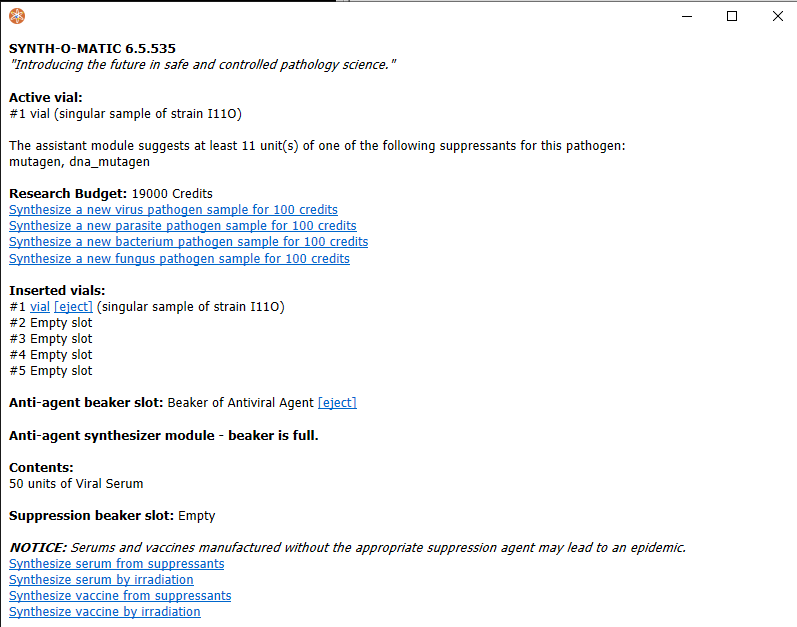
- Take a blood sample from an infected person using a syringe.
- Inject the blood into a blood slide. There are some around the lab and in the path-o-matic vendor.
- Put the blood slide into a microscope and check what kind of Microbody you are dealing with. You will need to know this to figure out the appropriate anti-agent. You can check these in the table here.
- Put the blood slide and a clean petri dish into a centrifuge and start it.

- After a short time, you should have a proper pathogen sample inside the petri dish. Take it out of the machine.
- Give it nutrient to grow more of it as outlined in the Pathogen Growing section.
- Put some of the samples from this into vials and put the vials into the Synth-O-Matic.

- Add some of the appropriate anti-agent from the Path-O-Matic vendor and pick the anti-agent option when putting it in. Don't worry about the suppressant option, it is not necessary right now.
- Once both things are in the Synth-O-Matic, simply click the vial in the list of inserted vials and then select the Synthesize serum by irradiation option.
- After a second or two, the machine should spit out some cures. If you did everything correctly, stabbing one of these into someone should put the infection into remission. (If you did not, they will instead infect people.)
Curing via Suppression
Do you not have access to QM or a Pathology Lab? Do you not want to do any fancy science stuff? Then this is the section for you.
Figure out the Suppressant as described in the section on Suppressants up above. Then expose yourself to it until your Pathogen goes into remission. It's that simple!
A humble health analyzer will tell you the Suppressant Group of the disease. From then you really only have two different options that you need to try. You'll know you have the right Suppressant if you get a message about feeling better, or if the Stage of your Infection (as seen on the health analyzer) decreases.
Supplementary Video
